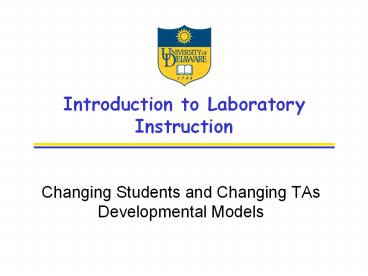Introduction to Laboratory Instruction - PowerPoint PPT Presentation
Title:
Introduction to Laboratory Instruction
Description:
Introduction to Laboratory Instruction. Changing Students and Changing TAs ... Make decisions about ... of Graduate TAs. ( pp 61- 88) Anker Publishing ... – PowerPoint PPT presentation
Number of Views:23
Avg rating:3.0/5.0
Title: Introduction to Laboratory Instruction
1
Introduction to Laboratory Instruction
- Changing Students and Changing TAs Developmental
Models
2
Topics for Today
- Perry Model for Intellectual and Ethical
Development during College - Nyquist Model for TA Development
3
Introduction to the Perry ModelStages of
epistemological and ethical growth
- Includes Ability To
- Understand the nature of knowledge, and how it is
acquired - Interpret the roles of authority
- Make decisions about complex life dilemmas
- (from D. Finster, Applying development theory
May Improve Teaching Wittenberg Today, Nov/Dec
1987)
4
The Stripped Down Three-Stage Perry
Model(from 9 phase that must be experienced
sequentially)
5
Focus on Dualism in the ClassroomFrom, A Model
for College Teaching by Knefelkamp and Widick
- Attributes
- 1. Expects to be told what to do.
- 2. Thinks the right answer is out there and
authority knows . - 3. Gets frustrated with authority who wont give
clear-cut answer. - 4. When sees differences of opinion, is either
confused or thinks its a trick to get us to
figure it out.
- Developmental Cues
- 1. No body will tell me what I should major in.
- 2. Which is the right interpretation of this
poem. - 3. Dr. Smith is a lousy teacher. He keeps telling
us all this conflicting stuff and wont tell us
which is right. - 4. I know she said there are a couple of ways to
do this problem. I wonder which one is right.
6
Dualism Cont. - Classroom Expectations
- Role of Authority
- Teach the right answer to students, and relay
them in a straight-forward fashion tell whats
expected for tests. - Take an active interest in students.
- Role of Peers
- Do not contribute to learning, but can be used
by instructor to come up with answer. - Clarify points to let others they are
experiencing problems. - Classroom as a Whole
- Structured, with limited diversity lecture.
- Present material in straight-forward, factual
manner tell students only what they need to
know. - Instructor must care and want students to learn.
7
Indicators of TA Development Indicators of TA Development Indicators of TA Development
Senior Learner Colleague-in-Training Junior Colleague
Concerns Self/survival How will the students like me? Skills How do I lecture, discuss? Outcomes Are the students getting it?
Discourse Level Pre-socialized Give simplistic explanations Socialized Talk like insiders, use technical language Post-socialized Make complex ideas clear without use of jargon
Approach to Authority Dependent Rely on supervisor Independent or Counter-dependent. Stand on own ideas-defiant at times Independent/collegial Begin to relate to faculty as partners in meeting instructional challenges
Approach to Students Engaged/vulnerable student as friend, victim, or enemy Love students, want to be friends, expect admiration, or are hurt, angry in response and personalize interactions Detached student as experimental subject Disengage or distance themselves from students-Becoming analytical about learning relationships Engaged/professional student as client Understand student/.instructor relationships and thee collaborative effort required for student learning to occur
From Jody D. Nyquist and Jo Sprague (1998)
Thinking Developmentally about TAs. In M.
Marinovich, J. Prostho, F. Stout (Eds.), The
Professional Development of Graduate TAs. (pp 61-
88) Anker Publishing































